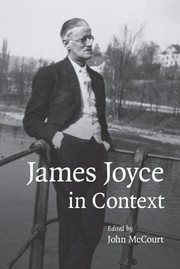Book contents
- Frontmatter
- Contents
- Notes on contributors
- Preface
- List of abbreviations
- PART I LIFE AND WORKS
- PART II THEORY AND CRITICAL RECEPTION
- PART III HISTORICAL AND CULTURAL CONTEXTS
- 14 Being in Joyce's world
- 15 Dublin
- 16 Nineteenth-century lyric nationalism
- 17 The Irish Revival
- 18 The English literary tradition
- 19 Paris
- 20 Trieste
- 21 Greek and Roman themes
- 22 Medicine
- 23 Modernisms
- 24 Music
- 25 Irish and European politics: nationalism, socialism, empire
- 26 Newspapers and popular culture
- 27 Language and languages
- 28 Philosophy
- 29 Religion
- 30 Science
- 31 Cinema
- 32 Sex
- Further reading
- Index
18 - The English literary tradition
Published online by Cambridge University Press: 14 July 2009
- Frontmatter
- Contents
- Notes on contributors
- Preface
- List of abbreviations
- PART I LIFE AND WORKS
- PART II THEORY AND CRITICAL RECEPTION
- PART III HISTORICAL AND CULTURAL CONTEXTS
- 14 Being in Joyce's world
- 15 Dublin
- 16 Nineteenth-century lyric nationalism
- 17 The Irish Revival
- 18 The English literary tradition
- 19 Paris
- 20 Trieste
- 21 Greek and Roman themes
- 22 Medicine
- 23 Modernisms
- 24 Music
- 25 Irish and European politics: nationalism, socialism, empire
- 26 Newspapers and popular culture
- 27 Language and languages
- 28 Philosophy
- 29 Religion
- 30 Science
- 31 Cinema
- 32 Sex
- Further reading
- Index
Summary
This chapter will not attempt to trace Joyce's literary precursors, in English literature or elsewhere, for that would be an unending task. I shall be concerned, instead, with Joyce's explicit references to English literature and English writers, and especially with writers whose names and achievements take on a symbolic significance in his works. One such example is Percy Bysshe Shelley, whose eight-line fragment beginning ‘Art thou pale for weariness’ helps Stephen Dedalus to transcend his adolescent self-pity during his schooldays at Belvedere College. Some years later, when he is expounding his aesthetic theory to his fellow student Lynch, a more mature Stephen invokes Shelley's image of the creative mind as a ‘fading coal’ (P 231). As a poet, Shelley cannot be said to prefigure any aspect of Joyce's art except for the brief lyrics of Chamber Music, yet Joyce took it as a good omen when in 1906, on the first day of his first visit to Rome, he came across a plaque marking the house in which The Cenci and Prometheus Unbound had been written some ninety years earlier. Two weeks later, he seems to have taken his family to see Shelley's tomb in the Protestant cemetery (SL 90, 95). This visit stayed in his memory, since ‘Shelley's grave in Rome’ features in his notes to Exiles written in 1913 (PE 346).
- Type
- Chapter
- Information
- James Joyce in Context , pp. 205 - 215Publisher: Cambridge University PressPrint publication year: 2009

